You are using an out of date browser. It may not display this or other websites correctly.
You should upgrade or use an alternative browser.
You should upgrade or use an alternative browser.
Astronomy Picture of the Day
- Thread starter poopoy
- Start date
Discover the cosmos! Each day a different image or photograph of our fascinating universe is featured, along with a brief explanation written by a professional astronomer.
2010 April 15
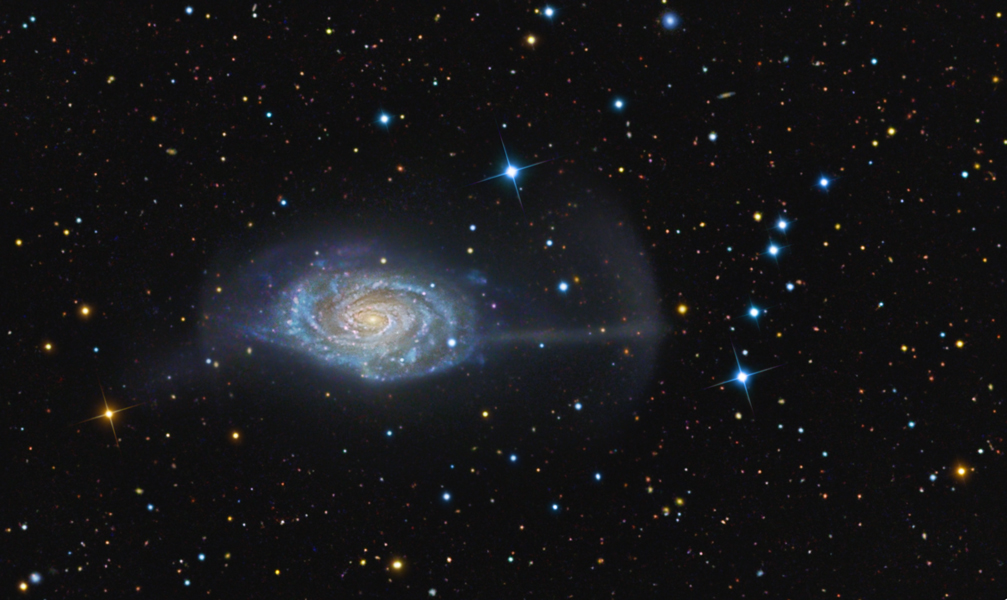
NGC 4651: The Umbrella Galaxy
Image Credit & Copyright: R Jay Gabany (Blackbird Obs.), Collaboration: David Martinez-Delgado (MPIA, IAC), et al. Explanation: Spiral galaxy NGC 4651 is a mere 35 million light-years distant, toward the well-groomed constellation Coma Berenices. About 50 thousand light-years across, this galaxy is seen to have a faint umbrella-shaped structure (right) that seems to extend some 50 thousand light-years farther, beyond the bright galactic disk. The giant cosmic umbrella is now known to be composed of tidal star streams. The streams themselves are extensive trails of stars gravitationally stripped from a smaller satellite galaxy that was eventually torn apart. Placing your cursor over the image will superimpose a simulation of the satellite galaxy's path as it was disrupted and absorbed into NGC 4651. Recent work by a remarkable collaboration of amateur and professional astronomers to image faint structures around bright galaxies suggests that even in nearby galaxies, such tidal star streams are common. The result is predicted by models of galaxy formation, including the formation of our Milky Way.
2010 April 15

NGC 4651: The Umbrella Galaxy
Image Credit & Copyright: R Jay Gabany (Blackbird Obs.), Collaboration: David Martinez-Delgado (MPIA, IAC), et al. Explanation: Spiral galaxy NGC 4651 is a mere 35 million light-years distant, toward the well-groomed constellation Coma Berenices. About 50 thousand light-years across, this galaxy is seen to have a faint umbrella-shaped structure (right) that seems to extend some 50 thousand light-years farther, beyond the bright galactic disk. The giant cosmic umbrella is now known to be composed of tidal star streams. The streams themselves are extensive trails of stars gravitationally stripped from a smaller satellite galaxy that was eventually torn apart. Placing your cursor over the image will superimpose a simulation of the satellite galaxy's path as it was disrupted and absorbed into NGC 4651. Recent work by a remarkable collaboration of amateur and professional astronomers to image faint structures around bright galaxies suggests that even in nearby galaxies, such tidal star streams are common. The result is predicted by models of galaxy formation, including the formation of our Milky Way.
Discover the cosmos! Each day a different image or photograph of our fascinating universe is featured, along with a brief explanation written by a professional astronomer.
2010 April 16
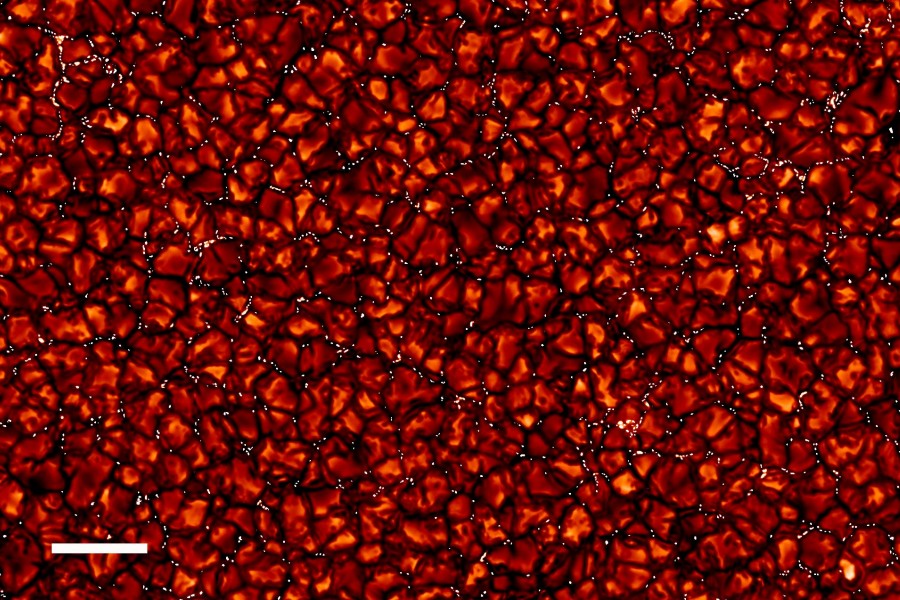
Bright Points on the Quiet Sun
Credit: J. Sanchez Almeida (IAC), et al. Explanation: Up close, the solar surface is a striking patch work of granules in this very high resolution picture of the quiet Sun. Caused by convection, the granules are hot, rising columns of plasma edged by dark lanes of cooler, descending plasma. But the high-resolution view reveals that the dark lanes are dotted with many small, contrasting bright points. Constantly present on the solar surface, the bright points do not seem to be related to sunspots that come and go with the magnetic solar cycle. Nonetheless, the bright points are regions of concentrated magnetic fields and are bright because the magnetic pressure opens a window to hotter deeper layers below the photosphere. For scale, the white bar at the lower left corresponds to 5,000 kilometers across the Sun's surface. The sharp, narrow-band image was recorded in September, 2007 using the Swedish Solar Telescope on the astronomical island of La Palma.
2010 April 16

Bright Points on the Quiet Sun
Credit: J. Sanchez Almeida (IAC), et al. Explanation: Up close, the solar surface is a striking patch work of granules in this very high resolution picture of the quiet Sun. Caused by convection, the granules are hot, rising columns of plasma edged by dark lanes of cooler, descending plasma. But the high-resolution view reveals that the dark lanes are dotted with many small, contrasting bright points. Constantly present on the solar surface, the bright points do not seem to be related to sunspots that come and go with the magnetic solar cycle. Nonetheless, the bright points are regions of concentrated magnetic fields and are bright because the magnetic pressure opens a window to hotter deeper layers below the photosphere. For scale, the white bar at the lower left corresponds to 5,000 kilometers across the Sun's surface. The sharp, narrow-band image was recorded in September, 2007 using the Swedish Solar Telescope on the astronomical island of La Palma.
Discover the cosmos! Each day a different image or photograph of our fascinating universe is featured, along with a brief explanation written by a professional astronomer.
2010 April 17
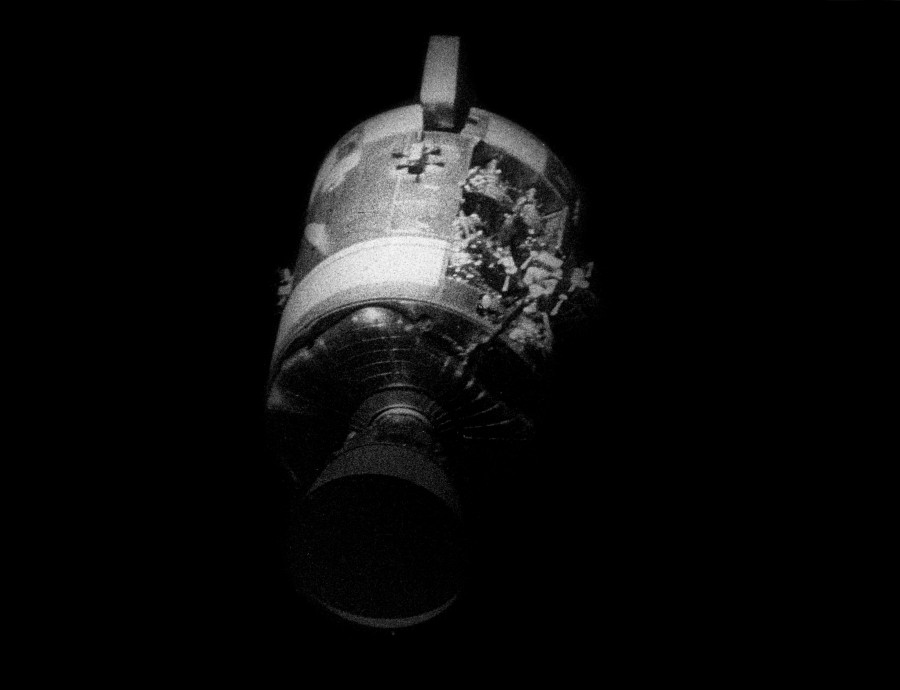
Damage to Apollo 13
Credit: Apollo 13 Crew, NASA Explanation: After an oxygen tank exploded and crippled their service module, the Apollo 13 astronauts were forced to abandon plans to make the third manned lunar landing. The extent of the damage is revealed in this grainy, grim photo, taken as the service module was drifting away, jettisoned only hours prior to the command module's reentry and splashdown. An entire panel on the side of the service module has been blown away and extensive internal damage is apparent. Visible below the gutted compartment is a radio antenna and the large, bell-shaped nozzle of the service module's rocket engine. On April 17, 1970 the three astronauts returned safely to Earth.
2010 April 17

Damage to Apollo 13
Credit: Apollo 13 Crew, NASA Explanation: After an oxygen tank exploded and crippled their service module, the Apollo 13 astronauts were forced to abandon plans to make the third manned lunar landing. The extent of the damage is revealed in this grainy, grim photo, taken as the service module was drifting away, jettisoned only hours prior to the command module's reentry and splashdown. An entire panel on the side of the service module has been blown away and extensive internal damage is apparent. Visible below the gutted compartment is a radio antenna and the large, bell-shaped nozzle of the service module's rocket engine. On April 17, 1970 the three astronauts returned safely to Earth.
Discover the cosmos! Each day a different image or photograph of our fascinating universe is featured, along with a brief explanation written by a professional astronomer.
2010 April 18
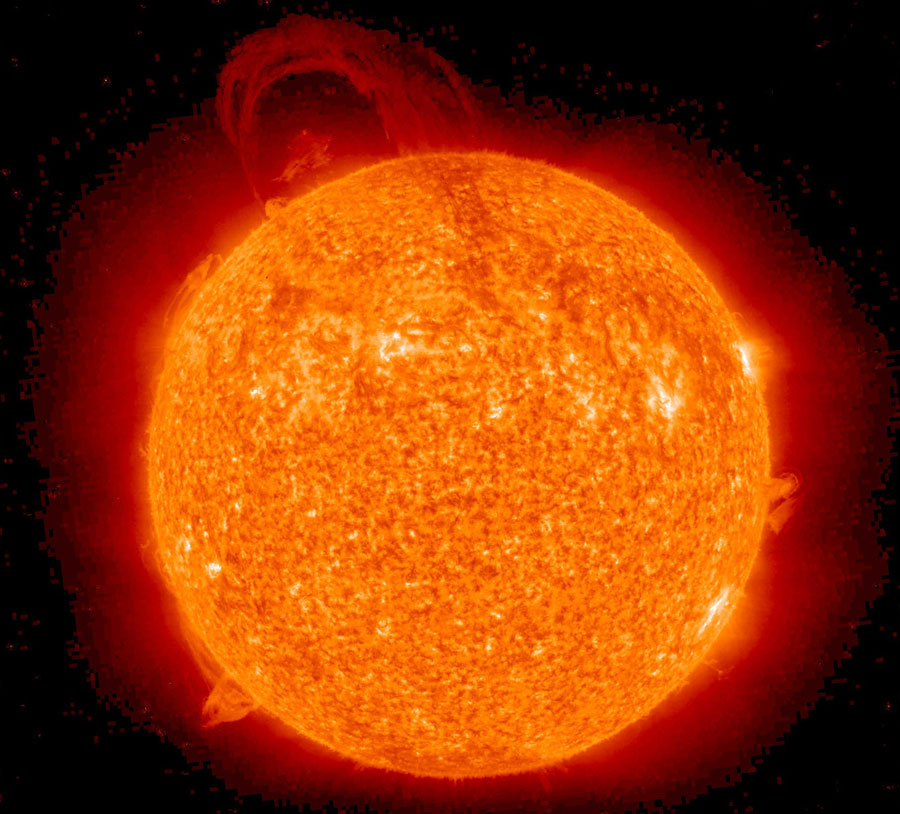
Large Eruptive Prominence Imaged by STEREO
Credit: STEREO Project, NASA Explanation: What's happened to our Sun? Last week, it produced one of the largest eruptive prominences ever seen. Pictured above, the prominence erupted in only a few hours and was captured in movie form by NASA's twin Sun-orbiting STEREO satellites. A quiescent solar prominence is a cloud of hot solar gas held above the Sun's surface by the Sun's magnetic field. Unpredictably, however, prominences may erupt, expelling hot gas into the Solar System via a Coronal Mass Ejection (CME). As pictured above, many Earths would easily fit under the expanding ribbon of hot gas. Although somehow related to the Sun's changing magnetic field, the energy mechanism that creates and sustains a Solar prominence is still a topic of research.
2010 April 18

Large Eruptive Prominence Imaged by STEREO
Credit: STEREO Project, NASA Explanation: What's happened to our Sun? Last week, it produced one of the largest eruptive prominences ever seen. Pictured above, the prominence erupted in only a few hours and was captured in movie form by NASA's twin Sun-orbiting STEREO satellites. A quiescent solar prominence is a cloud of hot solar gas held above the Sun's surface by the Sun's magnetic field. Unpredictably, however, prominences may erupt, expelling hot gas into the Solar System via a Coronal Mass Ejection (CME). As pictured above, many Earths would easily fit under the expanding ribbon of hot gas. Although somehow related to the Sun's changing magnetic field, the energy mechanism that creates and sustains a Solar prominence is still a topic of research.
Discover the cosmos! Each day a different image or photograph of our fascinating universe is featured, along with a brief explanation written by a professional astronomer.
2010 April 19
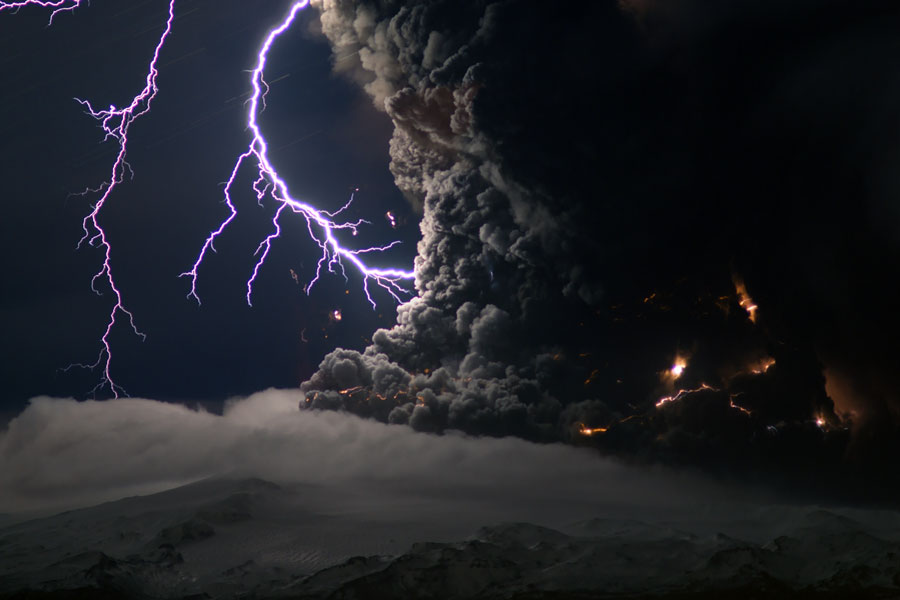
Ash and Lightning Above an Icelandic Volcano
Credit & Copyright: Marco Fulle (Stromboli Online) Explanation: Why did the recent volcanic eruption in Iceland create so much ash? Although the large ash plume was not unparalleled in its abundance, its location was particularly noticeable because it drifted across such well populated areas. The Eyjafjallajökull volcano in southern Iceland began erupting on March 20, with a second eruption starting under the center of small glacier on April 14. Neither eruption was unusually powerful. The second eruption, however, melted a large amount of glacial ice which then cooled and fragmented lava into gritty glass particles that were carried up with the rising volcanic plume. Pictured above two days ago, lightning bolts illuminate ash pouring out of the Eyjafjallajökull volcano.
2010 April 19

Ash and Lightning Above an Icelandic Volcano
Credit & Copyright: Marco Fulle (Stromboli Online) Explanation: Why did the recent volcanic eruption in Iceland create so much ash? Although the large ash plume was not unparalleled in its abundance, its location was particularly noticeable because it drifted across such well populated areas. The Eyjafjallajökull volcano in southern Iceland began erupting on March 20, with a second eruption starting under the center of small glacier on April 14. Neither eruption was unusually powerful. The second eruption, however, melted a large amount of glacial ice which then cooled and fragmented lava into gritty glass particles that were carried up with the rising volcanic plume. Pictured above two days ago, lightning bolts illuminate ash pouring out of the Eyjafjallajökull volcano.
Astronomy Picture of the Day
Discover the cosmos! Each day a different image or photograph of our fascinating universe is featured, along with a brief explanation written by a professional astronomer.
2010 April 21
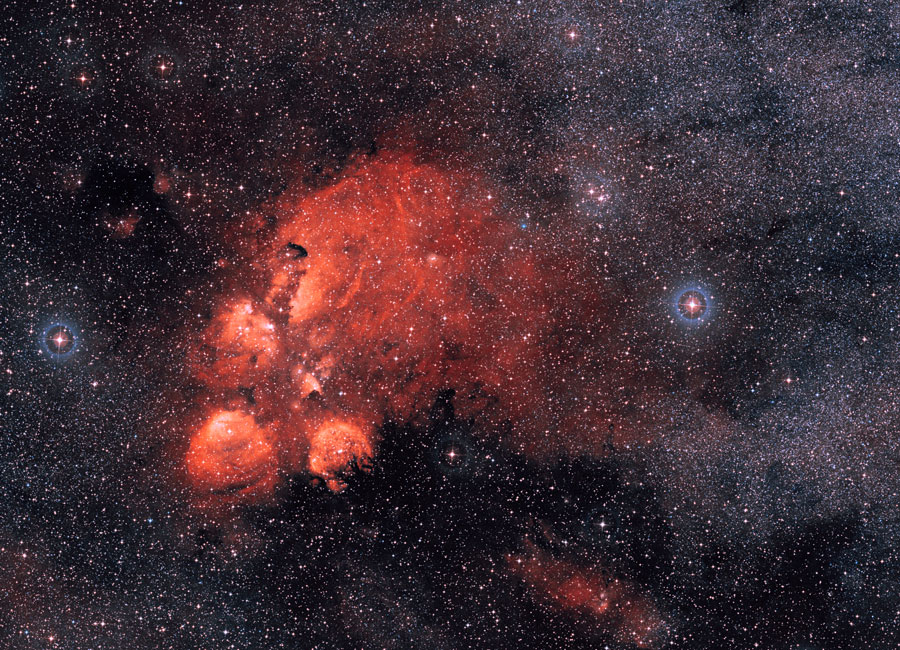
Wide Angle: The Cat's Paw Nebula
Credit: ESO, DSS2 Explanation: Nebulae are perhaps as famous for being identified with familiar shapes as perhaps cats are for getting into trouble. Still, no known cat could have created the vast Cat's Paw Nebula visible in [ame="http://www.youtube.com/watch?v=ni5LdzvLY7o"]Scorpius[/ame]. At 5,500 light years distant, Cat's Paw is an emission nebula with a red color that originates from an abundance of ionized hydrogen atoms. Alternatively known as the Bear Claw Nebula or NGC 6334, stars nearly ten times the mass of our Sun have been born [ame="http://www.youtube.com/watch?v=r3kZZ6EeEMg"]there[/ame] in only the past few million years. Pictured above, a wide angle, deep field image of the [ame="http://www.youtube.com/watch?v=v0zgQAp7EYw"]Cat's Paw[/ame] nebula was culled from the second Digitized Sky Survey.
Tomorrow's picture: open space
Discover the cosmos! Each day a different image or photograph of our fascinating universe is featured, along with a brief explanation written by a professional astronomer.
2010 April 21

Wide Angle: The Cat's Paw Nebula
Credit: ESO, DSS2 Explanation: Nebulae are perhaps as famous for being identified with familiar shapes as perhaps cats are for getting into trouble. Still, no known cat could have created the vast Cat's Paw Nebula visible in [ame="http://www.youtube.com/watch?v=ni5LdzvLY7o"]Scorpius[/ame]. At 5,500 light years distant, Cat's Paw is an emission nebula with a red color that originates from an abundance of ionized hydrogen atoms. Alternatively known as the Bear Claw Nebula or NGC 6334, stars nearly ten times the mass of our Sun have been born [ame="http://www.youtube.com/watch?v=r3kZZ6EeEMg"]there[/ame] in only the past few million years. Pictured above, a wide angle, deep field image of the [ame="http://www.youtube.com/watch?v=v0zgQAp7EYw"]Cat's Paw[/ame] nebula was culled from the second Digitized Sky Survey.
Tomorrow's picture: open space
Discover the cosmos! Each day a different image or photograph of our fascinating universe is featured, along with a brief explanation written by a professional astronomer.
2010 April 20
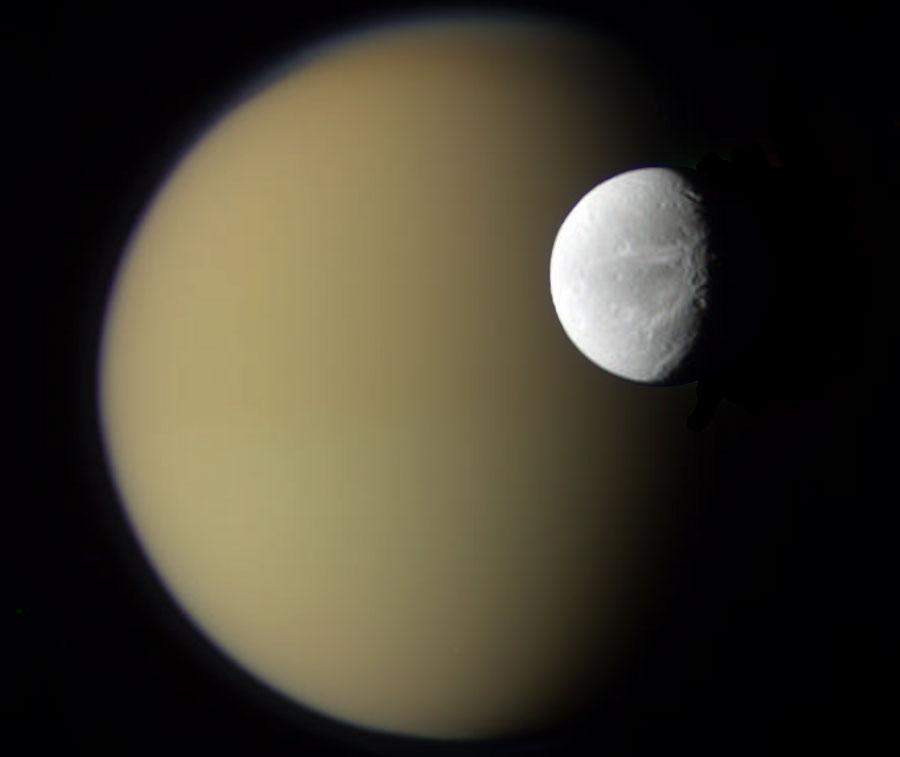
Saturn's Moons Dione and Titan from Cassini
Credit: NASA/JPL/SSI; Color composite: Emily Lakdawalla Explanation: What would it be like to see a sky with many moons? Such is the sky above Saturn. When appearing close to each other, moons will show a similar phase. A view with two of the more famous moons of Saturn in gibbous phase was captured last month by the robot spacecraft Cassini now orbiting Saturn. Titan, on the left, is among the largest moons in the Solar System and is perpetually shrouded in clouds. In 2005, the Huygens probe landed on Titan and gave humanity its first view of its unusual surface. Dione, on the right, has less than a quarter of Titan's diameter and has no significant atmosphere. The above uncalibrated image was taken on April 10 after Cassini swooped by each moon the previous week.
2010 April 20

Saturn's Moons Dione and Titan from Cassini
Credit: NASA/JPL/SSI; Color composite: Emily Lakdawalla Explanation: What would it be like to see a sky with many moons? Such is the sky above Saturn. When appearing close to each other, moons will show a similar phase. A view with two of the more famous moons of Saturn in gibbous phase was captured last month by the robot spacecraft Cassini now orbiting Saturn. Titan, on the left, is among the largest moons in the Solar System and is perpetually shrouded in clouds. In 2005, the Huygens probe landed on Titan and gave humanity its first view of its unusual surface. Dione, on the right, has less than a quarter of Titan's diameter and has no significant atmosphere. The above uncalibrated image was taken on April 10 after Cassini swooped by each moon the previous week.
Discover the cosmos! Each day a different image or photograph of our fascinating universe is featured, along with a brief explanation written by a professional astronomer.
2010 April 25
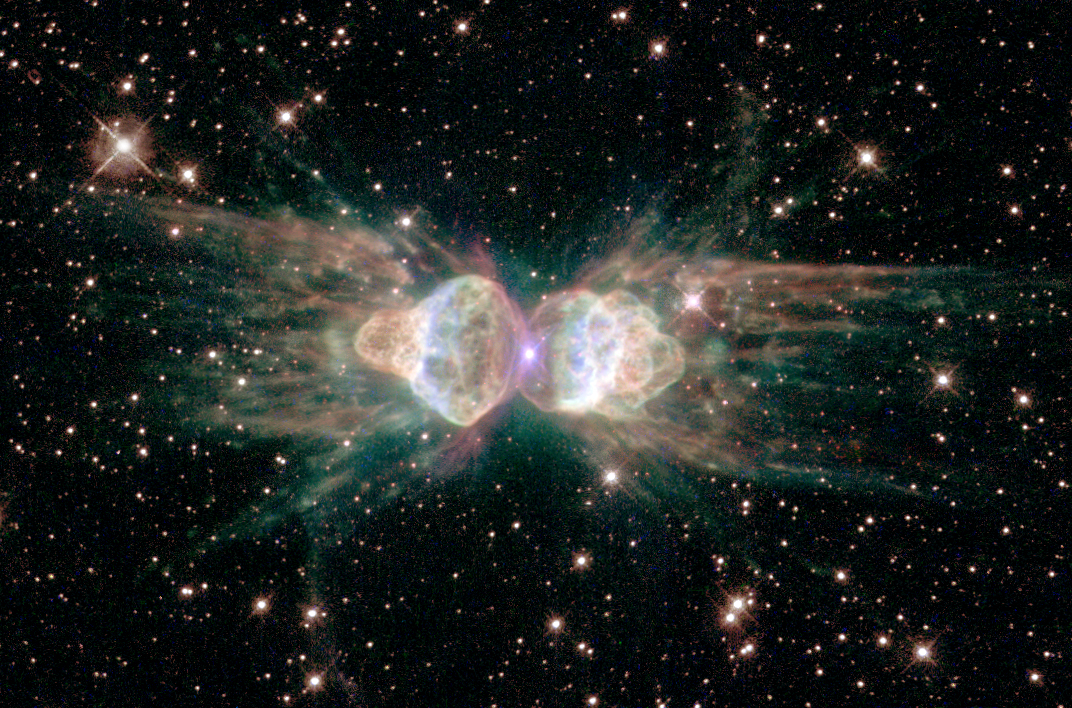
Planetary Nebula Mz3: The Ant Nebula
Credit: R. Sahai (JPL) et al., Hubble Heritage Team, ESA, NASA
Explanation: Why isn't this ant a big sphere? Planetary nebula Mz3 is being cast off by a star similar to our Sun that is, surely, round. Why then would the gas that is streaming away create an ant-shaped nebula that is distinctly not round? Clues might include the high 1000-kilometer per second speed of the expelled gas, the light-year long length of the structure, and the magnetism of the star visible above at the nebula's center. One possible answer is that Mz3 is hiding a second, dimmer star that orbits close in to the bright star. A competing hypothesis holds that the central star's own spin and magnetic field are channeling the gas. Since the central star appears to be so similar to our own Sun, astronomers hope that increased understanding of the history of this giant space ant can provide useful insight into the likely future of our own Sun and Earth.
2010 April 25

Planetary Nebula Mz3: The Ant Nebula
Credit: R. Sahai (JPL) et al., Hubble Heritage Team, ESA, NASA
Explanation: Why isn't this ant a big sphere? Planetary nebula Mz3 is being cast off by a star similar to our Sun that is, surely, round. Why then would the gas that is streaming away create an ant-shaped nebula that is distinctly not round? Clues might include the high 1000-kilometer per second speed of the expelled gas, the light-year long length of the structure, and the magnetism of the star visible above at the nebula's center. One possible answer is that Mz3 is hiding a second, dimmer star that orbits close in to the bright star. A competing hypothesis holds that the central star's own spin and magnetic field are channeling the gas. Since the central star appears to be so similar to our own Sun, astronomers hope that increased understanding of the history of this giant space ant can provide useful insight into the likely future of our own Sun and Earth.
Discover the cosmos! Each day a different image or photograph of our fascinating universe is featured, along with a brief explanation written by a professional astronomer.
2010 April 22
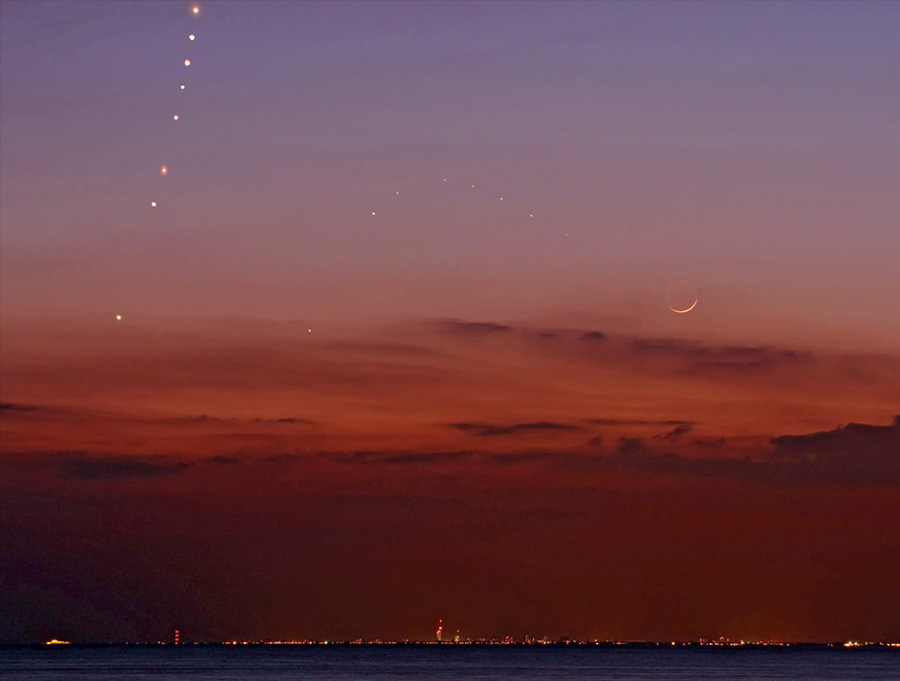
Venus, Mercury, and Moon
Credit & Copyright: Pete Lawrence (Digital-Astronomy) Explanation: Earlier this month, Venus and Mercury climbed into the western twilight, entertaining skygazers around planet Earth in a lovely conjunction of evening stars. Combining 8 images spanning April 4 through April 15, this composite tracks their progress through skies above Portsmouth, UK. Each individual image was captured at 19:50 UT. The sequential path for both bright planets begins low and to the left. But while Venus continues to swing away from the setting Sun, moving higher above the western horizon, Mercury first rises then falls. Its highest point is from the image taken on April 11. Of course on April 15, Venus and Mercury were joined by a young crescent Moon.
2010 April 22

Venus, Mercury, and Moon
Credit & Copyright: Pete Lawrence (Digital-Astronomy) Explanation: Earlier this month, Venus and Mercury climbed into the western twilight, entertaining skygazers around planet Earth in a lovely conjunction of evening stars. Combining 8 images spanning April 4 through April 15, this composite tracks their progress through skies above Portsmouth, UK. Each individual image was captured at 19:50 UT. The sequential path for both bright planets begins low and to the left. But while Venus continues to swing away from the setting Sun, moving higher above the western horizon, Mercury first rises then falls. Its highest point is from the image taken on April 11. Of course on April 15, Venus and Mercury were joined by a young crescent Moon.
Discover the cosmos! Each day a different image or photograph of our fascinating universe is featured, along with a brief explanation written by a professional astronomer.
2010 April 23
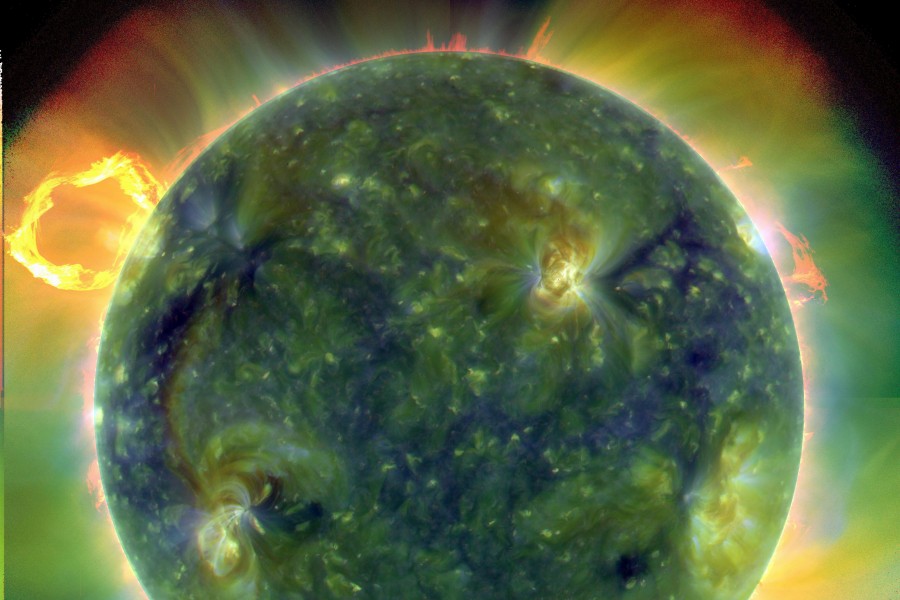
SDO: The Extreme Ultraviolet Sun
Credit: NASA / Goddard / SDO AIA Team Explanation: Don't panic, the Sun has not gone wild. But this wild-looking portrait of the nearest star to planet Earth was made on March 30th by the recently launched Solar Dynamics Observatory (SDO). Shown in false-color, the composite view covers extreme ultraviolet wavelengths and traces hot plasma at temperatures approaching 1 million kelvins. At full resolution, SDO image data is intended to explore solar activity in unprecedented detail. In fact, SDO will send 1.5 terabytes of data back each day, equivalent to a daily download of about half a million MP3 songs. New SDO data releases include a high-resolution movie of the large, eruptive prominence seen along the solar limb at the upper left.
2010 April 23

SDO: The Extreme Ultraviolet Sun
Credit: NASA / Goddard / SDO AIA Team Explanation: Don't panic, the Sun has not gone wild. But this wild-looking portrait of the nearest star to planet Earth was made on March 30th by the recently launched Solar Dynamics Observatory (SDO). Shown in false-color, the composite view covers extreme ultraviolet wavelengths and traces hot plasma at temperatures approaching 1 million kelvins. At full resolution, SDO image data is intended to explore solar activity in unprecedented detail. In fact, SDO will send 1.5 terabytes of data back each day, equivalent to a daily download of about half a million MP3 songs. New SDO data releases include a high-resolution movie of the large, eruptive prominence seen along the solar limb at the upper left.
Discover the cosmos! Each day a different image or photograph of our fascinating universe is featured, along with a brief explanation written by a professional astronomer.
2010 April 24
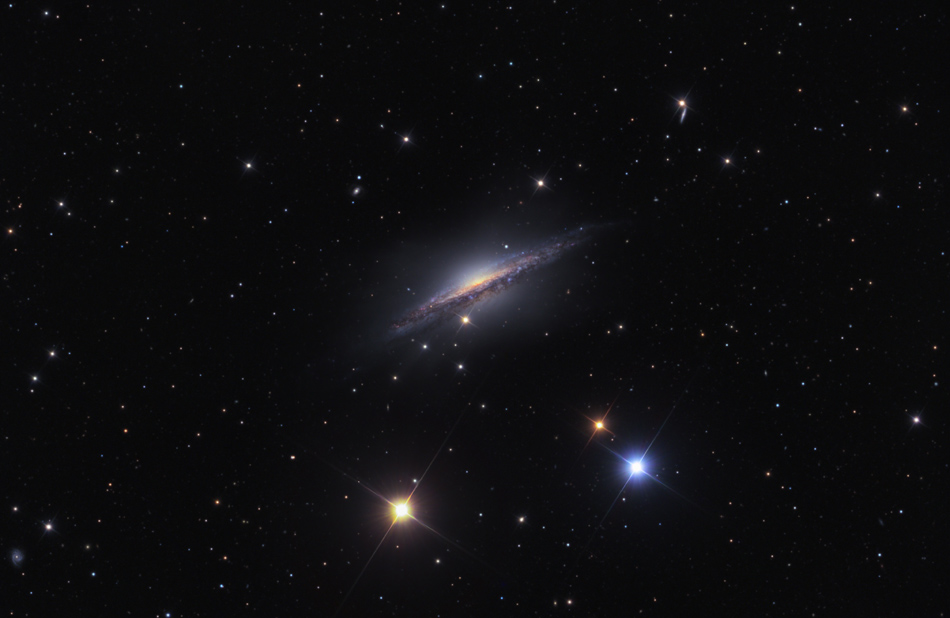
NGC 1055: Galaxy in a Box
Image Credit & Copyright: Ken Crawford (Rancho Del Sol Obs.), Collaboration: David Martinez-Delgado (MPIA, IAC), et al. Explanation: Big, beautiful spiral galaxy NGC 1055 is a dominant member of a small galaxy group a mere 60 million light-years away toward the intimidating constellation Cetus. Seen edge-on, the island universe spans about 100,000 light-years, similar in size to our own Milky Way. Colorful, spiky stars in this cosmic portrait of NGC 1055 are in the foreground, well within the Milky Way. But along with a smattering of more distant background galaxies, the deep image also reveals a curious box-shaped inner halo extending far above and below this galaxy's dusty plane. The halo itself is laced with faint, narrow structures, and could represent the mixed and spread out debris from a satellite galaxy disrupted by the larger spiral some 10 billion years ago.
2010 April 24

NGC 1055: Galaxy in a Box
Image Credit & Copyright: Ken Crawford (Rancho Del Sol Obs.), Collaboration: David Martinez-Delgado (MPIA, IAC), et al. Explanation: Big, beautiful spiral galaxy NGC 1055 is a dominant member of a small galaxy group a mere 60 million light-years away toward the intimidating constellation Cetus. Seen edge-on, the island universe spans about 100,000 light-years, similar in size to our own Milky Way. Colorful, spiky stars in this cosmic portrait of NGC 1055 are in the foreground, well within the Milky Way. But along with a smattering of more distant background galaxies, the deep image also reveals a curious box-shaped inner halo extending far above and below this galaxy's dusty plane. The halo itself is laced with faint, narrow structures, and could represent the mixed and spread out debris from a satellite galaxy disrupted by the larger spiral some 10 billion years ago.
Discover the cosmos! Each day a different image or photograph of our fascinating universe is featured, along with a brief explanation written by a professional astronomer.
2010 April 25

Planetary Nebula Mz3: The Ant Nebula
Credit: R. Sahai (JPL) et al., Hubble Heritage Team, ESA, NASA
Explanation: Why isn't this ant a big sphere? Planetary nebula Mz3 is being cast off by a star similar to our Sun that is, surely, round. Why then would the gas that is streaming away create an ant-shaped nebula that is distinctly not round? Clues might include the high 1000-kilometer per second speed of the expelled gas, the light-year long length of the structure, and the magnetism of the star visible above at the nebula's center. One possible answer is that Mz3 is hiding a second, dimmer star that orbits close in to the bright star. A competing hypothesis holds that the central star's own spin and magnetic field are channeling the gas. Since the central star appears to be so similar to our own Sun, astronomers hope that increased understanding of the history of this giant space ant can provide useful insight into the likely future of our own Sun and Earth.
Discover the cosmos! Each day a different image or photograph of our fascinating universe is featured, along with a brief explanation written by a professional astronomer.
2010 April 26
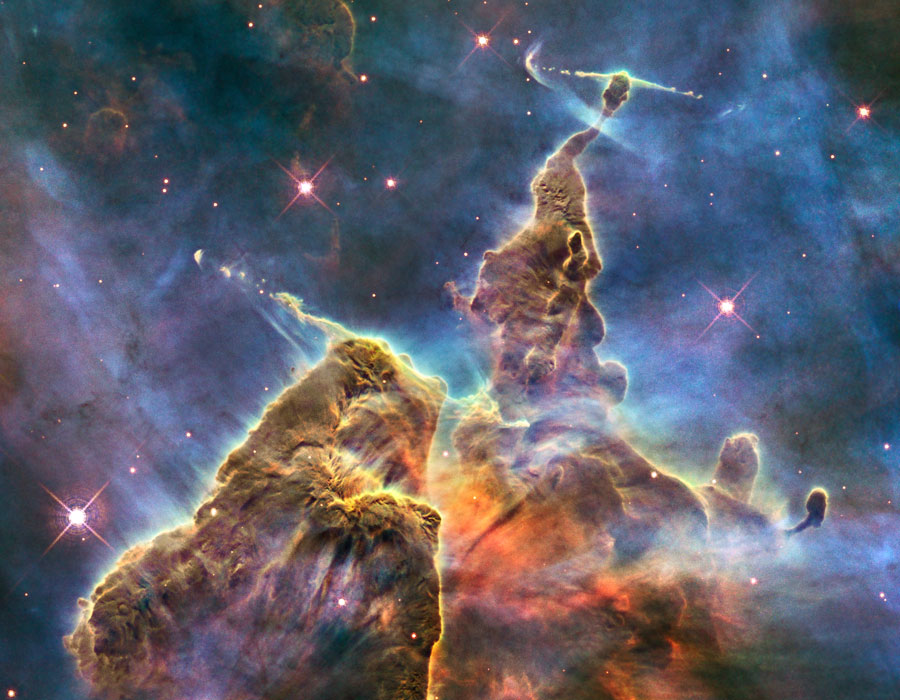
Dust Pillar of the Carina Nebula
Credit: NASA, ESA, and M. Livio and the Hubble 20th Anniversary Team (STScI) Explanation: Inside the head of this interstellar monster is a star that is slowly destroying it. The monster, on the right, is actually an inanimate pillar of gas and dust that measures over a light year in length. The star, not itself visible through the opaque dust, is bursting out partly by ejecting energetic beams of particles. Similar epic battles are being waged all over the star-forming Carina Nebula. The stars will win in the end, destroying their pillars of creation over the next 100,000 years, and resulting in a new open cluster of stars. The pink dots around the image are newly formed stars that have already been freed from their birth monster. The above image was released last week in commemoration of the Hubble Space Telescopes 20th year of operation. The technical name for the stellar jets are Herbig-Haro objects. How a star creates Herbig-Haro jets is an ongoing topic of research, but it likely involves an accretion disk swirling around a central star. A second impressive Herbig-Haro jet occurs diagonally near the image center.
2010 April 26

Dust Pillar of the Carina Nebula
Credit: NASA, ESA, and M. Livio and the Hubble 20th Anniversary Team (STScI) Explanation: Inside the head of this interstellar monster is a star that is slowly destroying it. The monster, on the right, is actually an inanimate pillar of gas and dust that measures over a light year in length. The star, not itself visible through the opaque dust, is bursting out partly by ejecting energetic beams of particles. Similar epic battles are being waged all over the star-forming Carina Nebula. The stars will win in the end, destroying their pillars of creation over the next 100,000 years, and resulting in a new open cluster of stars. The pink dots around the image are newly formed stars that have already been freed from their birth monster. The above image was released last week in commemoration of the Hubble Space Telescopes 20th year of operation. The technical name for the stellar jets are Herbig-Haro objects. How a star creates Herbig-Haro jets is an ongoing topic of research, but it likely involves an accretion disk swirling around a central star. A second impressive Herbig-Haro jet occurs diagonally near the image center.
Discover the cosmos! Each day a different image or photograph of our fascinating universe is featured, along with a brief explanation written by a professional astronomer.
2010 April 27
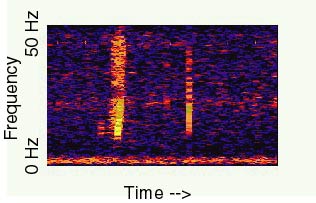
The Bloop: A Mysterious Sound from the Deep Ocean
Credit: NOAA, SOSUS
Explanation: What created this strange sound in Earth's Pacific Ocean? Pictured above is a visual representation of a loud and unusual sound, dubbed a Bloop, captured by deep sea microphones in 1997. In the above graph, time is shown on the horizontal axis, deep pitch is shown on the vertical axis, and brightness designates loudness. Although Bloops are some of the loudest sounds of any type ever recorded in Earth's oceans, their origin remains unknown. The Bloop sound was placed as occurring several times off the southern coast of South America and was audible 5,000 kilometers away. Although the sound has similarities to those vocalized by living organisms, not even a blue whale is large enough to croon this loud. The sounds point to the intriguing hypothesis that even larger life forms lurk in the unexplored darkness of Earth's deep oceans. A less imagination-inspiring possibility, however, is that the sounds resulted from some sort of iceberg calving. No further Bloops have been heard since 1997, although other loud and unexplained sounds have been recorded.
Tomorrow's picture: open space
2010 April 27

The Bloop: A Mysterious Sound from the Deep Ocean
Credit: NOAA, SOSUS
Explanation: What created this strange sound in Earth's Pacific Ocean? Pictured above is a visual representation of a loud and unusual sound, dubbed a Bloop, captured by deep sea microphones in 1997. In the above graph, time is shown on the horizontal axis, deep pitch is shown on the vertical axis, and brightness designates loudness. Although Bloops are some of the loudest sounds of any type ever recorded in Earth's oceans, their origin remains unknown. The Bloop sound was placed as occurring several times off the southern coast of South America and was audible 5,000 kilometers away. Although the sound has similarities to those vocalized by living organisms, not even a blue whale is large enough to croon this loud. The sounds point to the intriguing hypothesis that even larger life forms lurk in the unexplored darkness of Earth's deep oceans. A less imagination-inspiring possibility, however, is that the sounds resulted from some sort of iceberg calving. No further Bloops have been heard since 1997, although other loud and unexplained sounds have been recorded.
Tomorrow's picture: open space
Discover the cosmos! Each day a different image or photograph of our fascinating universe is featured, along with a brief explanation written by a professional astronomer.
2010 April 27

The Bloop: A Mysterious Sound from the Deep Ocean
Credit: NOAA, SOSUS Explanation: What created this strange sound in Earth's Pacific Ocean? Pictured above is a visual representation of a loud and unusual sound, dubbed a Bloop, captured by deep sea microphones in 1997. In the above graph, time is shown on the horizontal axis, deep pitch is shown on the vertical axis, and brightness designates loudness. Although Bloops are some of the loudest sounds of any type ever recorded in Earth's oceans, their origin remains unknown. The Bloop sound was placed as occurring several times off the southern coast of South America and was audible 5,000 kilometers away. Although the sound has similarities to those vocalized by living organisms, not even a blue whale is large enough to croon this loud. The sounds point to the intriguing hypothesis that even larger life forms lurk in the unexplored darkness of Earth's deep oceans. A less imagination-inspiring possibility, however, is that the sounds resulted from some sort of iceberg calving. No further Bloops have been heard since 1997, although other loud and unexplained sounds have been recorded.

2010 April 27

The Bloop: A Mysterious Sound from the Deep Ocean
Credit: NOAA, SOSUS Explanation: What created this strange sound in Earth's Pacific Ocean? Pictured above is a visual representation of a loud and unusual sound, dubbed a Bloop, captured by deep sea microphones in 1997. In the above graph, time is shown on the horizontal axis, deep pitch is shown on the vertical axis, and brightness designates loudness. Although Bloops are some of the loudest sounds of any type ever recorded in Earth's oceans, their origin remains unknown. The Bloop sound was placed as occurring several times off the southern coast of South America and was audible 5,000 kilometers away. Although the sound has similarities to those vocalized by living organisms, not even a blue whale is large enough to croon this loud. The sounds point to the intriguing hypothesis that even larger life forms lurk in the unexplored darkness of Earth's deep oceans. A less imagination-inspiring possibility, however, is that the sounds resulted from some sort of iceberg calving. No further Bloops have been heard since 1997, although other loud and unexplained sounds have been recorded.
Discover the cosmos! Each day a different image or photograph of our fascinating universe is featured, along with a brief explanation written by a professional astronomer.
2010 April 28

Sunset on a Golden Sea
Image Credit & Copyright: Pete Lawrence (Digital-Astronomy) Explanation: On April 17, the sky was clear and the Sun's colour was spectacular as night approached. This striking telescopic view even captures the Sun's swollen and distorted shape from the southern coast of the UK. Reflecting a bright column of sunlight, the sea also appears golden, with the horizon marked by the city of Portsmouth. Were the colours made more intense by volcanic dust? Maybe not. Normally, sunset (and sunrise) colours can still be very dramatic, especially when the atmosphere is clear and the Sun is viewed very near the horizon, as in this scene. But large dust particles, like those in the airline-thwarting ash clouds from the erupting Icelandic volcano Eyjafjallajökull, tend to create diffuse and subdued sunset colours.
2010 April 28

Sunset on a Golden Sea
Image Credit & Copyright: Pete Lawrence (Digital-Astronomy) Explanation: On April 17, the sky was clear and the Sun's colour was spectacular as night approached. This striking telescopic view even captures the Sun's swollen and distorted shape from the southern coast of the UK. Reflecting a bright column of sunlight, the sea also appears golden, with the horizon marked by the city of Portsmouth. Were the colours made more intense by volcanic dust? Maybe not. Normally, sunset (and sunrise) colours can still be very dramatic, especially when the atmosphere is clear and the Sun is viewed very near the horizon, as in this scene. But large dust particles, like those in the airline-thwarting ash clouds from the erupting Icelandic volcano Eyjafjallajökull, tend to create diffuse and subdued sunset colours.
Discover the cosmos! Each day a different image or photograph of our fascinating universe is featured, along with a brief explanation written by a professional astronomer.
2010 April 29

Virgo Cluster Galaxy NGC 4731
Image Credit & Copyright: Stephen Leshin Explanation: Barred spiral galaxy NGC 4731 lies some 65 million light-years away. The lovely island universe resides in the large Virgo cluster of galaxies. Colors in this well-composed, cosmic portrait, highlight plentiful, young, bluish star clusters along the galaxy's sweeping spiral arms. Its broad arms are distorted by gravitational interaction with a fellow Virgo cluster member, giant elliptical galaxy NGC 4697. NGC 4697 is beyond this frame above and to the left, but a smaller irregular galaxy NGC 4731A can be seen near the bottom in impressive detail with its own young blue star clusters. Of course, the individual, colorful, spiky stars in the scene are much closer, within our own Milky Way galaxy. NGC 4731 itself is well over 100,000 light-years across.
2010 April 29

Virgo Cluster Galaxy NGC 4731
Image Credit & Copyright: Stephen Leshin Explanation: Barred spiral galaxy NGC 4731 lies some 65 million light-years away. The lovely island universe resides in the large Virgo cluster of galaxies. Colors in this well-composed, cosmic portrait, highlight plentiful, young, bluish star clusters along the galaxy's sweeping spiral arms. Its broad arms are distorted by gravitational interaction with a fellow Virgo cluster member, giant elliptical galaxy NGC 4697. NGC 4697 is beyond this frame above and to the left, but a smaller irregular galaxy NGC 4731A can be seen near the bottom in impressive detail with its own young blue star clusters. Of course, the individual, colorful, spiky stars in the scene are much closer, within our own Milky Way galaxy. NGC 4731 itself is well over 100,000 light-years across.
Discover the cosmos! Each day a different image or photograph of our fascinating universe is featured, along with a brief explanation written by a professional astronomer.
2010 April 30
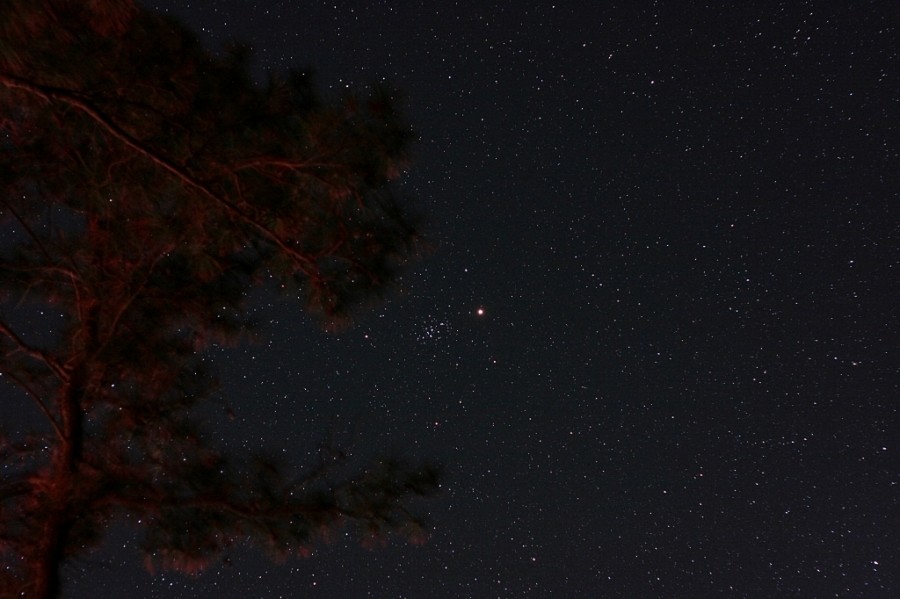
Mars in a Manger
Image Credit & Copyright: John Ambrose Explanation: At opposition in late January, Mars shone very brightly in planet Earth's night sky, among the stars of the constellation Cancer the Crab. Since then the Red Planet has been fading, but still lingers in Cancer during April and May. In mid-April, Mars wandered remarkably close to Cancer's famous star cluster M44, the Beehive Cluster. M44 is also known by an older name, Praesepe, Latin for cradle or manger. Captured in this 60 second time exposure made on April 14, a yellow-tinged Mars and M44 are near the center of the field, seemingly just beyond the reach of a pine tree. Of course, M44's stars are about 600 light-years away, while Mars was more like 600 light-seconds from Earth. The digital photograph was made with a camera mounted on a telescope tracking the stars through dark skies above a camp ground in Virginia, USA. During the exposure, passing car lights briefly illuminated the tree branches.
2010 April 30

Mars in a Manger
Image Credit & Copyright: John Ambrose Explanation: At opposition in late January, Mars shone very brightly in planet Earth's night sky, among the stars of the constellation Cancer the Crab. Since then the Red Planet has been fading, but still lingers in Cancer during April and May. In mid-April, Mars wandered remarkably close to Cancer's famous star cluster M44, the Beehive Cluster. M44 is also known by an older name, Praesepe, Latin for cradle or manger. Captured in this 60 second time exposure made on April 14, a yellow-tinged Mars and M44 are near the center of the field, seemingly just beyond the reach of a pine tree. Of course, M44's stars are about 600 light-years away, while Mars was more like 600 light-seconds from Earth. The digital photograph was made with a camera mounted on a telescope tracking the stars through dark skies above a camp ground in Virginia, USA. During the exposure, passing car lights briefly illuminated the tree branches.
Discover the cosmos! Each day a different image or photograph of our fascinating universe is featured, along with a brief explanation written by a professional astronomer.
2010 May 1

A Pulsar's Hand
Credit: P. Slane (Harvard-Smithsonian CfA) et al., CXC, NASA
Explanation: As far as pulsars go, PSR B1509-58 appears young. Light from the supernova explosion that gave birth to it would have first reached Earth some 1,700 years ago. The magnetized, 20 kilometer-diameter neutron star spins 7 times per second, a cosmic dynamo that powers a wind of charged particles. The energetic wind creates the surrounding nebula's X-ray glow in this tantalizing image from the Chandra X-ray Observatory. Low energy X-rays are in red, medium energies in green, and high energies in blue. The pulsar itself is in the bright central region. Remarkably, the nebula's tantalizing, complicated structure resembles a hand. PSR B1509-58 is about 17,000 light-years away in the southern constellation Circinus. At that distance the Chandra image spans 100 light-years.
2010 May 1

A Pulsar's Hand
Credit: P. Slane (Harvard-Smithsonian CfA) et al., CXC, NASA
Explanation: As far as pulsars go, PSR B1509-58 appears young. Light from the supernova explosion that gave birth to it would have first reached Earth some 1,700 years ago. The magnetized, 20 kilometer-diameter neutron star spins 7 times per second, a cosmic dynamo that powers a wind of charged particles. The energetic wind creates the surrounding nebula's X-ray glow in this tantalizing image from the Chandra X-ray Observatory. Low energy X-rays are in red, medium energies in green, and high energies in blue. The pulsar itself is in the bright central region. Remarkably, the nebula's tantalizing, complicated structure resembles a hand. PSR B1509-58 is about 17,000 light-years away in the southern constellation Circinus. At that distance the Chandra image spans 100 light-years.



